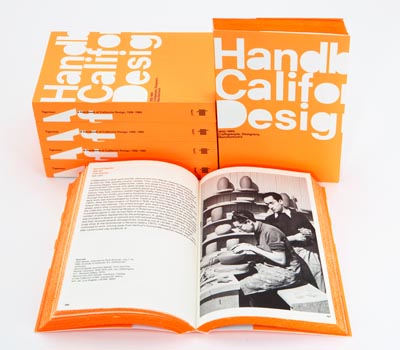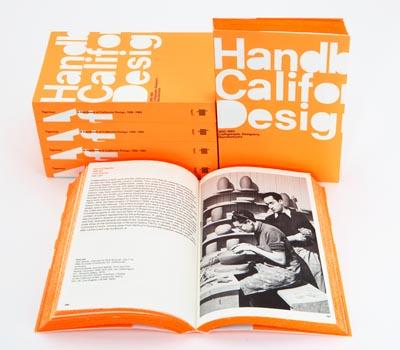While LACMA’s 2011 California Design exhibition circles the globe (it’s at the National Art Center, Tokyo for a few more weeks before it packs up and moves to the Auckland Art Gallery this summer, the Queensland Art Gallery in November, and finally ends at the Peabody Essex Museum in Salem, Mass. in Spring 2014), the Decorative Arts and Design department has been busily working on a companion book, A Handbook of California Design, 1930-1965: Craftspeople, Designers, Manufacturers. While organizing the exhibition, the research team turned up file cabinets full of new information about California designers and craftspeople. There was no way that we could squeeze it all into the exhibition catalogue, and we quickly realized that a second book was inevitable. I served as editor of the book, and in considering what form it would take, I immediately thought of the Dutch designer Irma Boom. Irma is an internationally renowned graphic designer--last year she received the Medal of Honor for Art and Science from Queen Beatrix of the Netherlands and she recently completed the new graphic identity and house style for the just re-opened Rijksmuseum in Amsterdam. I met Irma while working on the book Knoll Textiles and from that experience, knew that her conception of the ‘book as object’ made her the perfect designer for this project, which is all about objects of design. We spoke recently about the design process and why she chose to work on the Handbook of California Design.
Irma Boom will speak at LACMA on Thursday, May 30 about her career, the place of books in contemporary society, and her experience designing LACMA’s Handbook of California Design. For more information and to buy tickets, click here.
 Photo courtesy Los Angeles Modern Auctions (LAMA)
Photo courtesy Los Angeles Modern Auctions (LAMA)
Bobbye Tigerman: Irma, your services are in very high demand and you can be selective about which projects you take. Why did you choose to design the Handbook of California Design?
Irma Boom: If I design a book, I do it because I want to learn from its content. I didn’t know that there were so many outstanding California designers working at mid-century. Of course I knew the very famous ones, like Saul Bass and Charles and Ray Eames, but I was interested to learn more about some of the more obscure designers. The text is also clear and beautifully written. Each entry is concise but very informative.
BT: What were your design inspirations for this book?
IB: The content was already developed, so it was not difficult to organize the information. A beautiful book about Comme des Garçons inspired the bright orange color and the texture of the edges.
BT: Were there any particular challenges that you faced with this book?
IB: There weren’t any major hurdles. The book has a very clear structure—each spread is devoted to one designer or craftsperson and has a brief biography and an image. It was important to me to emphasize the many connections between the designers so I created a diagram at the beginning of the book that visually demonstrated the networks and collaborations.
BT: What is your favorite aspect of the book?
IB: The clarity of the content and design.
BT: How does the book fit into your larger oeuvre?
IB: It has a clear structure—the content and design are one. And like many books I design, I conceive of it as a complete object, including the cover materials, the paper, the binding, the inks, the edges. It is a total experience.
BT: As we see the landscape of book design and production changing rapidly, you have been a strong proponent of the printed word. Why do you continue to design books, and why are they important?
IB: In this age of constant flux, the book becomes even more important than it was before. Information printed in black and white on physical paper is “frozen.” I find that printed text is much more thoroughly researched and proofed, as it cannot be changed instantly like text on the internet. I make books where the object—the three-dimensional, physical experience—is key. My books are not PDFs. Their materiality—their size, paper, and weight—are important ingredients and play a critical role in all the decisions I make. The book is a container of ideas and thoughts because of its intrinsic qualities. I believe in the renaissance of the book.
Bobbye Tigerman, Associate Curator, Decorative Arts and Design



